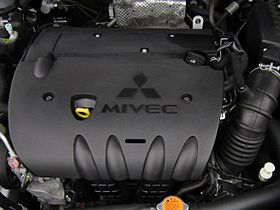| Mitsubishi 4B1 engine | |
|---|---|
 | |
| Overview | |
| Manufacturer | Mitsubishi Motors |
| Also called | World Engine |
| Production | 2007–present |
| Layout | |
| Configuration | Inline-four |
| Displacement |
|
| Cylinder bore | 86 mm (3.39 in) 88 mm (3.46 in) |
| Piston stroke | 77.4 mm (3.05 in) 86 mm (3.39 in) 97 mm (3.82 in) |
| Cylinder block material | Aluminium die cast |
| Cylinder head material | Aluminium die cast |
| Valvetrain | Direct acting DOHC, 16 valves, continuously variable MIVEC intake and exhaust valve timing |
| Compression ratio | 9.0:1, 10.0:1, 10.5:1, |
| Combustion | |
| Turbocharger | On some versions |
| Fuel system | Fuel injection |
| Fuel type | Gasoline |
| Cooling system | Water-cooled |
| Output | |
| Power output | From 140 to 446 PS (103 to 328 kW; 138 to 440 bhp) |
| Torque output | From 14.5 to 56.961 kg⋅m (142 to 559 N⋅m; 105 to 412 lbf⋅ft) |
| Chronology | |
| Predecessor | Mitsubishi Sirius engine (Gasoline Engine) |
| Successor | Mitsubishi 4J1 engine (SOHC) Mitsubishi 4B4 engine (DOHC) |
The Mitsubishi 4B1 engine is a range of all-alloy straight-4 piston engines built at Mitsubishi's Japanese "World Engine" powertrain plant in Shiga on the basis of the Global Engine Manufacturing Alliance (GEMA).[1][2][3] Although the basic designs of the various engines are the same, their exact specifications are individually tailored for each partner (Chrysler, Mitsubishi, and Hyundai). The cylinder block and other basic structural parts of the engine were jointly developed by the GEMA companies, but the intake and exhaust manifolds, the cylinder head's intake and exhaust ports, and other elements related to engine tuning were independently developed by Mitsubishi.[1]
All engines developed within this family have aluminium cylinder block and head, 4 valves per cylinder, double overhead camshaft layouts, and MIVEC continuous variable valve timing. All variations of 4B1 engine share the same engine block with a 96 mm bore pitch. The difference in displacement is achieved by variance in bore and stroke.[4]
The 4B1 engine family is the first to have the continuously variable valve timing MIVEC system applied not only to its intake valves but also to its exhaust valves. The intake and exhaust cam timing is continuously independently controlled and provide four optimized engine operating modes.[1][5]
- ^ a b c "Newly Developed Four-Cylinder MIVEC Engine" Archived 2007-09-29 at the Wayback Machine, Masato TOJO, Akihito KUBO, .pdf file, Mitsubishi Motors technical review
- ^ "Mitsubishi Motors Makes Shiga Plant Japanese Production Facility of World Engine" Archived 2010-08-15 at the Wayback Machine, Mitsubishi Motors website
- ^ "DaimlerChrysler, Hyundai, and Mitsubishi Motors to Form Global Engine Alliance" Archived 2007-09-29 at the Wayback Machine, Mitsubishi Motors website
- ^ JDM Spec Engines - Mitsubishi 4B1-Series Engines[usurped]
- ^ "All-New 2008 Mitsubishi Lancer Delivers Driven-To-Thrill Performance from New 152 bhp (154 PS; 113 kW) Engine and Optional CVT" Archived 2007-10-22 at the Wayback Machine, Mitsubishi Motors North America press release